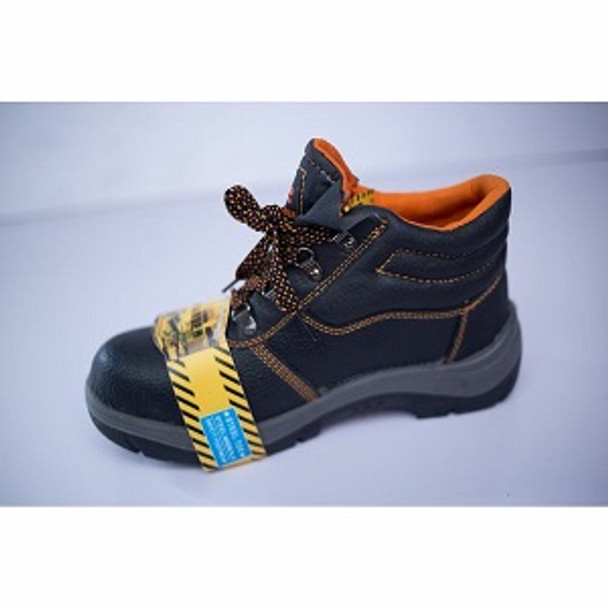Safety Boots Features: Understanding Ratings and Choosing the Right Protection
Key Takeaway
- Toe Protection: Steel or composite toe caps offer essential protection against heavy impacts and compression, making them crucial for industrial and construction environments.
- Sole Resistance: Look for features like slip resistance, puncture-proof soles, and anti-static properties to prevent injuries from slips, sharp objects, and electrical hazards.
- Waterproof and Breathable: Waterproof safety boots are ideal for wet conditions, while breathable materials help keep feet dry and comfortable during long work hours.
- Comfort and Durability: Prioritize features such as cushioned insoles, ankle support, and durable materials for long-lasting comfort and protection in tough work environments.
Introduction
Safety boots play a critical role in protecting workers across various industries, from construction sites to factories and warehouses. These boots are designed not only to provide comfort and support but also to protect against a range of workplace hazards, including slips, falls, and impacts.
Safety boots are designed with specific features that offer protection and comfort in hazardous work environments. One key feature is toe protection, which can be achieved with either steel or composite toe caps. For example, Ingco Safety Boots S3 provide excellent toe protection, ensuring that workers are safe from falling objects or compression. Another critical aspect is sole resistance, where boots like INGCO SSH02S1P (42) offer slip-resistant and puncture-proof soles to prevent accidents on slippery or sharp surfaces. Additionally, features like waterproofing and breathability are important for keeping feet dry in wet conditions while maintaining comfort during long workdays.
Finally, high-quality safety boots should prioritize comfort and durability, with cushioned insoles and strong construction to support workers throughout the day, such as the Safety Trainer Gironde Grey Dickies which combine both comfort and rugged durability. Choosing the right pair involves understanding these features and ensuring the appropriate level of protection for the job at hand.
Safety Boot SSH02S1P INGCO
Key Features of Safety Boots
1. Materials
The materials used in safety boots significantly influence their performance and durability:
1. Leather: Traditional safety boots are often made from high-quality leather, known for its durability and ability to withstand tough conditions. Leather boots offer excellent protection against abrasions and are typically water-resistant, making them suitable for outdoor work.
2. Synthetic Materials: Many modern safety boots incorporate synthetic materials, which can provide lighter weight options and enhanced breathability. These materials may also offer waterproof properties and greater flexibility, catering to different working conditions.
3. Waterproofing Features: Waterproof safety boots are essential for jobs in wet environments. Technologies like Gore-Tex or specially treated materials help keep feet dry, preventing discomfort and potential injuries related to moisture.
2. Sole Construction
The sole of a safety boot is crucial for ensuring grip and stability:
1. Slip Resistance: A slip-resistant sole is vital for preventing falls, particularly in workplaces where liquids or debris may be present. Look for soles that have been tested for slip resistance to ensure maximum safety.
2. Oil and Chemical Resistance: In environments where oil or chemicals are present, having a sole that can resist these substances is crucial. Specialized materials can help maintain traction and prevent degradation of the sole.
3. Electric Shock Resistance: Safety boots with electric shock resistance protect workers from electrical hazards, reducing the risk of shock when working near live electrical wires or equipment.
3. Toe Protection
One of the most important features of safety boots is toe protection:
1. Steel Toe: Steel toe boots are designed with a reinforced toe cap made from steel, offering maximum protection against heavy objects that could drop on the foot. They are the most common type of protective footwear in hazardous environments.
2. Composite Toe: For those looking for a lighter alternative, composite toe boots provide a non-metal option. They are made from materials like Kevlar or carbon fiber, offering similar protection without the weight of steel.
3. Aluminum Toe: Aluminum toe caps are another lightweight alternative to steel. They provide excellent protection and are a great option for workers who need to comply with safety regulations while reducing the overall weight of their footwear.
4. Ankle Support
Ankle support is crucial for preventing injuries, especially in environments where uneven surfaces are common:
1. Height of the Boot: Safety boots come in various heights, from ankle to mid-calf. Higher boots generally offer more support, making them suitable for tasks that require additional stability.
2. Design Features for Support: Look for boots with features like padded collars and built-in arch support to enhance comfort and reduce fatigue during long work hours.
5. Breathability and Comfort
Comfort is key to ensuring that workers can perform their duties effectively:
1. Moisture-Wicking Materials: Safety boots made with moisture-wicking materials help keep feet dry by drawing sweat away from the skin, reducing discomfort and the risk of blisters.
2. Cushioning and Insoles: Good cushioning in the soles and quality insoles can significantly enhance comfort, providing support for long hours on the feet.
Rocklander Resistant Safety Boot
Understanding Safety Ratings and Standards
1. Overview of Relevant Safety Standards
Safety standards ensure that footwear meets specific performance criteria to protect workers. Some of the most recognized standards include:
ASTM (American Society for Testing and Materials): This organization sets rigorous testing protocols for safety footwear. Standards like ASTM F2413 specify requirements for impact resistance, compression resistance, and electrical hazard protection.
ISO (International Organization for Standardization): ISO standards, such as ISO 20345, provide global benchmarks for safety footwear, ensuring that boots manufactured around the world meet similar safety criteria.
2. Explanation of Rating Systems
Understanding safety ratings is crucial when selecting the right boots. Here are key rating systems to be aware of:
1. Impact and Compression Ratings: Boots are rated for their ability to withstand impacts and compression. A boot with an impact rating of 75 or 50 means it can protect against impacts up to that force in pounds. This rating helps determine the level of protection provided against falling objects.
2. Slip Resistance Ratings: Safety boots are tested for their slip resistance on different surfaces, often rated with a letter grade or a specific coefficient. Higher ratings indicate better traction and lower risk of slipping.
3. Electrical Hazard Ratings: Boots with an electrical hazard rating provide insulation against electric shock. This rating is essential for workers who are exposed to electrical hazards, as it helps prevent serious injuries.
3. How to Interpret Safety Labels and Markings
When shopping for safety boots, it’s essential to look for the labels and markings that indicate compliance with safety standards. Familiarize yourself with symbols such as:
1. Steel Toe Symbol: Indicates that the boot has a steel toe cap for impact protection.
2. EH Symbol: Designates boots that meet electrical hazard standards.
3. Slip Resistance Symbol: Represents a boot’s slip resistance capabilities.
These markings help ensure that you choose the right pair of boots based on your specific workplace hazards.
Safety Boot INGCO SSH02S1P (42)
Choosing the Right Safety Boots
1. Assessing Workplace Hazards
Understanding the specific hazards present in your workplace is the first step in selecting the appropriate safety boots:
1. Types of Hazards: Identify the types of hazards you may encounter, such as falling objects, wet or slippery surfaces, sharp materials, or electrical hazards. This assessment will guide you in selecting boots with the necessary features for protection.
2. Industry-Specific Requirements: Different industries have varying safety regulations. For example, construction sites may require steel-toe boots, while chemical manufacturing might necessitate chemical-resistant footwear.
2. Fit and Comfort
Choosing safety boots that fit well is crucial for comfort and protection:
1. Importance of Proper Sizing: Always ensure that you get the correct size. Boots that are too tight can cause blisters and discomfort, while those that are too loose may not provide adequate support.
2. Trying on Boots and Walking Tests: Before purchasing, try on the boots with the socks you typically wear. Walk around to assess comfort and ensure that the boots provide adequate support without pinching or rubbing.
3. Budget Considerations
While investing in safety boots, consider the balance between cost and safety features:
1. Balancing Cost and Safety Features: Higher-priced boots often offer advanced safety features and durability. However, it's essential to evaluate whether these features align with your specific needs.
2. Long-Term Investment in Safety: Remember that safety boots are an investment in your well-being. Opting for quality over the lowest price can result in better protection and longer-lasting wear.
Safety Shoe Manager Safety Jogger
Maintenance and Care for Safety Boots
Proper maintenance and care can extend the life of safety boots and ensure they continue to provide adequate protection:
1. Cleaning and Storage Tips
1. Regular Cleaning: Clean your boots regularly to remove dirt and debris. Use a soft brush and mild soap for leather boots, and ensure synthetic materials are wiped down with a damp cloth.
2. Proper Storage: Store boots in a cool, dry place away from direct sunlight. Avoid keeping them in damp areas to prevent mold and mildew growth.
2. Regular Inspections for Wear and Tear
1. Inspect for Damage: Regularly check your boots for signs of wear, including sole deterioration, toe cap damage, and any leaks. Look for loose stitching or cracks in the material.
2. Address Issues Promptly: If you notice significant wear, replace your boots immediately to maintain protection.
3. When to Replace Safety Boots
Safety boots typically have a lifespan that varies based on use, but if you notice any of the following, it’s time to consider replacement:
1. Significant wear on the sole or upper material
2. Loss of waterproofing
3. Deformed structure affecting fit and support
Case Studies or Testimonials
Real-life examples of how safety boots have prevented injuries can illustrate their importance:
1. Case Study: A construction worker dropped a heavy tool on their foot while working at a height. Thanks to their steel-toe safety boots, they sustained no injuries. This case highlights the importance of choosing boots that meet safety standards.
2. Testimonials: Workers often report that their safety boots not only protect but also provide comfort throughout long shifts. Many appreciate features like cushioned insoles and moisture-wicking materials that keep their feet dry and comfortable.
Safety Boot Steel Toe Rocklander
Frequently Asked Questions
1. What are the main safety ratings for boots?
The main safety ratings include impact resistance, compression resistance, slip resistance, and electrical hazard ratings, which are indicated by specific standards like ASTM or ISO.
2. How do I know what size safety boots to buy?
Always try on safety boots with the socks you plan to wear at work. Walk around to check for comfort and ensure they fit snugly without being too tight.
3. Are waterproof safety boots necessary?
Waterproof safety boots are essential if you work in wet environments, as they help keep your feet dry and comfortable, reducing the risk of slips and injuries.
4. How often should I replace my safety boots?
Safety boots should be replaced if you notice significant wear, loss of waterproofing, or any damage that compromises their protective capabilities.
5. What features should I look for in safety boots for construction work?
Look for steel toe protection, slip-resistant soles, electrical hazard ratings, and ankle support to ensure maximum safety and comfort on construction sites.
Related Articles
The Best Safety Work Procedures for Welders in Nigeria
Safety Equipment in Nigeria 2024 Reviews
Readers also Watched...
Conclusion
Choosing the right safety boots is a vital decision that can significantly impact workplace safety. Understanding the features and ratings of safety boots ensures that workers can make informed choices based on their specific job requirements. Prioritizing safety in the workplace not only protects employees but also contributes to a culture of care and responsibility within organizations.
For the best selection of safety boots that meet your specific needs, visitGZ Industrial Supplies. Explore our wide range of quality safety footwear designed to keep you protected and comfortable on the job!













